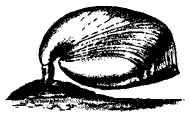
Brachiopoda main page
| Rhynchonelliformea | ||
| Brachiopoda | Athyridida |
| Metazoa | |||

The Athyridida, or Rostrospiracea as they were previously called, are a group of smooth-shelled , impunctate shells of rounded outline, having prominent beaks but no perceptible interarea on the pedicle valve
Externally, they resemble a few of the Atrypids, which also have a smooth shell. But they differ in the nature of the more complex brachidium, the athyrid brachidium sometimes bearing long pointed processes, or loops like scissor handles. Except for their spiral brachidium, directed laterally outward, they have almost nothing in common with the Spiriferida proper.
The external morphology is very variable in with group, with some genera resembling contemporary terebratulids such as Dielasma and Kingena, others being similar to Spirifer, and still others resembling rhynchonellids.
Athyrids were most abundant during the Silurian and Devonian periods, but still remained common during the early Carboniferous, and even as late as the Permian. One of the most abundant Carboniferous forms is Composita (above). This form was attached by a strong pedicle, probably in varying positions, like the living Terebratalia. Faunules composed mainly of Composita indicate an environment to which it was particularly adapted and not favored by most others brachiopods.
Athyrid ancestry is uncertain but they may have evolved from Atrypids which in turn descended from Rhynchonellids. Alternatively, they could have evolved directly from rhynchonellids independent of Atrypids.
On the left is the classification according to the Treatise on Invertebrate Paleontology. On the right is the newer classification by EuroBrachNet
| Treatise on Invertebrate Paleontology | Classification des Brachiopoda |
| Retziidina Retziacea (Middle Silurian-Permian) Athyrisinacea (Early Devonian-Triassic) |
Basal Taxa Dayioidea (Late Ordovician - Late Silurian) Anoplothecoidea (Late Silurian? - Middle Devonian?) Uncitoidea Athyrididina Meristelloidea (Late Ordovician--Early Carboniferous) Athyridoidea (?Late Ordovician-, Early Silurian-Late Triassic, ?Late Jurassic) Nucleospiroidea (Early Silurian- Early Permian) Retziidina Retzioidea (Early Silurian-Late Triassic) Rhynchospirinoidea (Early Silurian-Early Devonian) Mongolospiroidea (Early Devonian) Koninckinidina Koninckinoidea (Early Triassic-Early Jurassic) Cadomelloidea (Early Jurassic) |
| Athyrididina Athyridacea (Late Ordovician--Late Triassic) Koninckinoidea (Triassic-Jurassic) |
TENDENCIES IN THE ATHYRIDID DIVERSITY DYNAMICS
Fernando ALVAREZ1 and Tatiana L. MODZALEVSKAYA2.
"The Athyridia, is a rather rich and diverse group of spire-bearing brachiopods which appeared in the late Ordovician0, Hirnantian, possibly Caradoc. At the beginning of the Silurian (Llandovery-Wenlock) the origination number shows a clear increase towards younger strata. Athyridid diversification and dispersal during the early Silurian coincides with warming of the climate and transgression of the ocean. From Wenlock, the number of originations falls towards the younger strata while extinctions show the opposite course. Geographical limitations due to the general late Silurian marine regression may have had some influence. As a result, the late Silurian was the time of the first crisis when 16 genera became extinct.from The Fourth, Millennium, International Brachiopod Congress
A new athyridid fauna originated (40 genera appeared) in the early Devonian when the innovation and radiation rates were the highest. These sudden innovations could explain the rise of endemic genera that took place during this period. Later both origination and extinction fall quickly. Extinctions prevailed over appearances and this caused a rapid decline in the athyridids in the late Devonian. 30 genera disappear coinciding with the extinction episode (Frasnian/Famennian). Environmental factors, such as cooling and anoxia, more than marine regression seems to have played an important role in this F-F crisis. The rate of endemism falls from mid Devonian till late Carboniferous. During the Famennian, a clear process of recovery starts. The origination numbers rise until the second half of the Carboniferous system during which a 3rd crises take place (Serpukhovian episode?) and 19 genera disappear. The late Carboniferous athyridids were the most cosmopolitan. However from that time there was a clear tendency for the rate of cosmopolitan genera to decrease while an almost continuous (except during the late Triassic) rise in endemism took place. During the Permian, specially during late Permian, the origination data shows a small rise, but always below the rate of extinction. At the end of Permian, coinciding with the principal mass extinction episode of the Phanerozoic, there was a considerable rise in the extinction rate, 16 genera disappear close to the Permian-Triassic boundary. In the Triassic, with the appearance of the koninckinoids, the last recovery process took place. Origination and extinction show a clear increase (29 genera appear) but extinctions clearly prevailed over appearances, causing a quick decline of the order in latest Triassic. During this period, the level of innovation was low and specialization high, the number of cosmopolitan genera decreased drastically and endemic genera increase considerable. This considerable rise of endemic genera and decline of those widely distributed coincides with the general decline of the order, a decline that began with the widely distributed genera in the late Permian and during the Triassic. By the end of the Triassic a great increase in the extinction rate took place, most of the genera disappear, and the whole order became extinct by mid Jurassic, or at the end of the Jurassic system if the presence of Ochotathyris ochotica, in Qinghai (NW China) is finally confirmed."
 Brachiopoda main page |